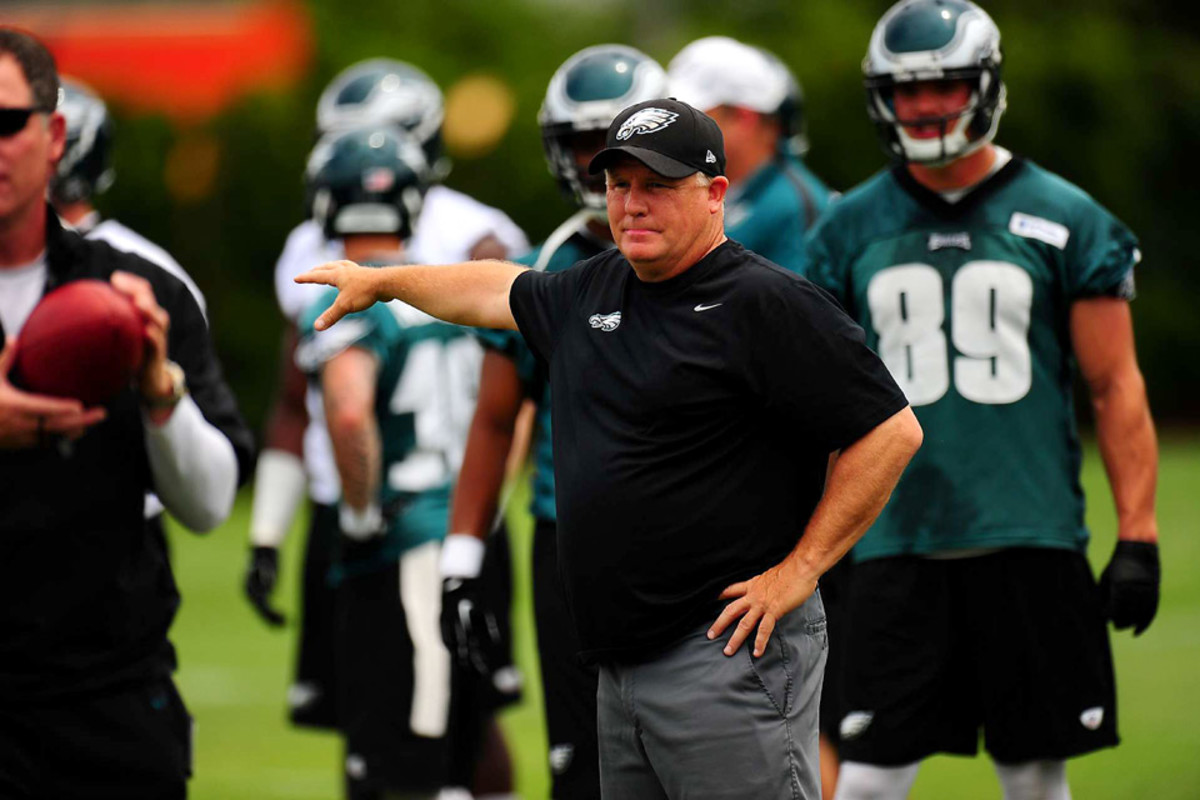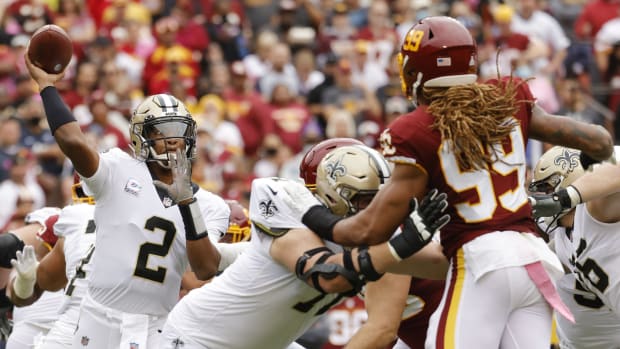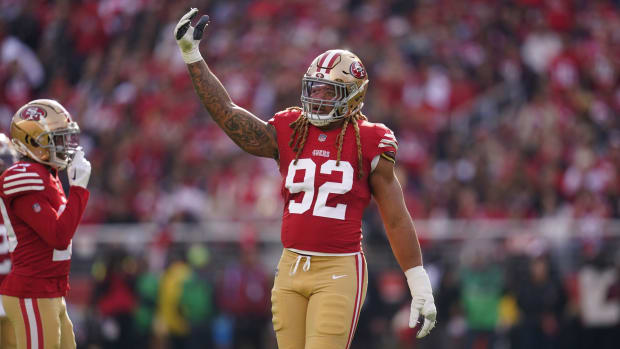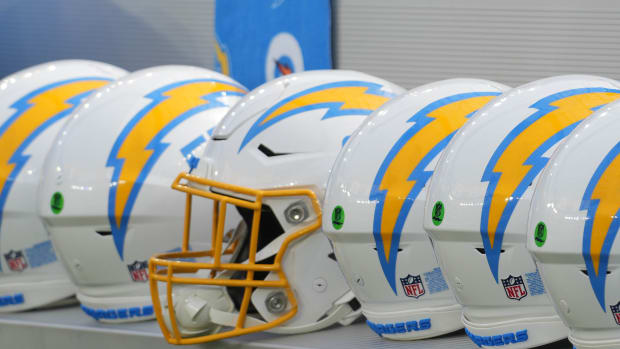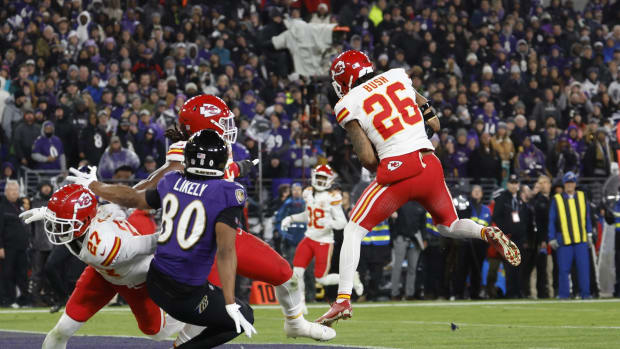Chip Kelly’s Mystery Man
From now until the opening of training camps, The MMQB will run a series of our Greatest Hits from the site’s first year. From July 2013, Jenny Vrentas profiles the NFL's first sports-science coordinator.
PHILADELPHIA — Tucked in the back of Connor Barwin’s uniform, between his shoulder blades, was a small black-and-orange gadget about the size of a hockey puck. Weighing just 30 grams, it contained a GPS, magnetometer, accelerometer and gyroscope that had just recorded his every movement on the practice field. But the Eagles linebacker would rather not talk about it.
“I don’t know if I’m supposed to,” Barwin said, glancing around after an organized team activities session in May. “I don’t want to, like, give up secrets?”
On Chip Kelly’s Eagles this is the new normal. Science and technology are part of nearly everything the team does. But the why and the how are treated like classified information.
And so is the who—in this case, the man hired by Kelly to be the first “sports-science coordinator” an NFL team has ever had. His name is Shaun Huls, and his background—nearly five years as a performance coach for the U.S. Naval Special Warfare Group 2—is as intriguing as his current job title.
Heads turned in February when Huls was listed in the announcement of the new coaching staff, and since then Kelly has taken care to preserve the mystery surrounding this aspect of his program. As training camp was set to open Huls had not yet been permitted to speak to the media, and The MMQB’s request for interviews with Kelly and general manager Howie Roseman about the sports-science initiative was turned down through a team spokesperson. At a press conference in June, Kelly would go only so far as to say that sports science is important because “what you do with your players is ultimately important.” He added, “I’d tell you I’m not a trendsetter by how I dress… We’re just trying to make our team better.”
Shaun Huls. (Courtesy of Philadelphia Eagles)
The Eagles are not the only NFL team to lean on science and technology in their training; the Giants, Jaguars and Falcons are also among the league’s leaders in this area. And similar practices are ingrained in international sports such as soccer, since the frontline for much of the sports-science research and technology development is overseas in Europe and Russia.
But there is an unmistakable curiosity about what is taking place in Philadelphia. Perhaps it’s because of Kelly’s reputation as an innovator, or the tie to the military’s most elite warriors, or the fact that the up-tempo offense Kelly became known for at Oregon is presumed to place special physical demands on his players.
Or perhaps it’s because we want to see if thinking beyond the X’s and O’s can really help turn around a team that went 4-12 last season. No matter the reason, there’s a story to be told about what’s going on inside the walls of the NovaCare Complex, even if it’s not one the Eagles are ready to tell.
***
Change is the order of the day in Philly after Andy Reid’s 14-year tenure. Some of what Kelly has wrought is obvious. His frenetic practices are set to deafening music of all genres—Kanye West and AC/DC and banquet-hall favorite “Cha Cha Slide”—that blares onto South Broad Street. And his staff introduced personalized protein shakes—center Jason Kelce’s contains blueberries, avocado, 2% milk and vanilla protein powder—that players grab on their way off the practice field.
Why not devote significant resources ... to a cutting-edge approach that will help keep players on the field and maximize their performance?
But remaking a program through the application of sports science is a bigger and more multifaceted undertaking. The premise is simple: Teams invest millions in players; why not devote significant resources, including a dedicated position on the coaching staff, to a cutting-edge approach that will help keep players on the field and maximize their performance? In mid-March, the Eagles began developing something of a sports-science laboratory. Team president Don Smolenski told the Philadelphia Inquirer the team invested more than $1 million in equipment and technology upgrades this offseason. In keeping with the air of secrecy, the companies that provided the technology were reluctant to share specifics of how the Eagles are using their devices.
The array of technology creates a physiological dashboard for each player. Among the equipment: Catapult Sports’ OptimEye sensors, which Barwin was wearing; heart-rate monitors from Polar; an Omegawave system that measures an athlete’s readiness for training and competition; and weight-lifting technology from a company named EliteForm, with 3-D cameras that record not just how much an athlete is lifting but how quickly he is doing it. There is also the low-tech end: Players are asked to urinate in a cup before practice to check their hydration levels.
The result is a data-driven approach to training, which is compatible with and perhaps even necessary for the way Kelly coaches. In the up-tempo style he brought from Oregon—the Ducks averaged more than 81 offensive plays per game last season—players are perpetually on the move. Some sports scientists, like the University of Connecticut’s William Kraemer, say research does not support the perception that an up-tempo pace imposes extreme fitness and recovery demands. But even so, sports-science technology can play an important role in preventing overuse, overtraining and the often accompanying soft-tissue injuries.
“Everyone is saying that going at this pace, people are going to burn out,” says offensive tackle Dennis Kelly, “but they’re making sure we’re getting the rest we need to recover.”
The OptimEye trackers, of which the Eagles have about 55, record a player’s movements through the course of a practice, allowing coaches to quantify acceleration, agility and the percentage of time the player is running at max speed versus standing around. An incentive not to slack off? Sure. But this is also a way to determine how much stress a workout places on a player’s body.
James Casey, one of the Eagles' new additions, is benefiting from Chip Kelly's innovative approach. (Matt Rourke/AP)
Monitoring heart rate is another way to gauge training load, as well as how close a player is at any given point of his workout to maximum exertion. The Polar system generates post-workout recovery reports, with a timestamp for when an athlete can next handle more training. Mike Valentino, Polar’s national sales manager for team sports, says a Big East women’s soccer team saw a 75% decrease in soft-tissue injuries during its first season using the technology. And the Omegawave system uses an electrocardiogram transmitter and a pair of electrodes that tap into the central nervous system to measure stress, fatigue and capacity for aerobic or anaerobic exercise. Players can log into their personal computers to check their own fitness profiles.
But data means the most when there’s an expert there to understand and apply it, and that’s where Huls comes in. Says Barwin, “If you’re suddenly more sore than usual, or you start to feel an injury pop up, you can go check with him and see what your numbers look like for that practice, and see why.”
Teams are not permitted to use tracking devices on players during games, but an NFL spokesman said there have been discussions with “several companies” about a possible league-wide initiative for in-game tracking, something the CBA would allow for if the players union consented. Forbes reported in May that Catapult, whose NFL clients also include the Giants and Cowboys, is in those discussions.
Still, there are ways to mine data to analyze game performance. Last season Catapult helped one of its NFL clients compare practice data off the OptimEye sensors in weeks when the team won compared to those when it lost. A trend emerged: During Thursday practices before losses, offensive skill players were running a lot but not very quickly. “They were training them to be slow,” says Gary McCoy, Catapult’s U.S. sales manager. “When they saw that, what we were hearing on the phone was, ‘S---, we really messed this up.’ You get those ‘Wow’ moments.”
***
The roots of the Eagles’ sports-science program reach back to Lincoln, Neb., in the late 1990s. This was the golden era of Husker Power, the Nebraska strength and conditioning program that powered three national championships between 1994 and ’97. During that time three ambitious college students began working with the school’s athletic department.
One of the students was Shaun Huls. At Nebraska, his philosophies on training (a reliance on free weights and explosive work) and nutrition (the cafeteria line was reorganized to have healthy vegetables first and meats last) were honed. Huls’s first chance to run his own strength and conditioning program was at Hampton (Va.) University in the mid-2000s. Joe Taylor, Hampton’s football coach at the time, considers Huls one of the best hires in his 40-year coaching career because of the way he transformed their training.
Huls timed players during their lifts, used diagnostic tests such as vertical jumps and shuttle runs to objectively track his players’ fitness, and reorganized the cafeteria line as at Nebraska—all practices he uses today in Philadelphia. Huls won the trust of the players, who gave him standing ovations at their athletic banquets.
Then came the really intriguing stuff: the nearly five years he spent training Navy SEALs at a military base in Virginia Beach. In August 2007 Huls, a civilian, became the first strength coach hired to work in the human performance program at Special Warfare Group 2. A practitioner of Brazilian jiu-jitsu, he’s the type of trainer who wants to experience the demands on his athletes, so he would do seven-mile ocean swims or carry around the SEALs’ 70-pound backpacks to feel the strain on his body. His hiring was part of a push by the Navy to train SEALs smarter, so his most important challenge was to reduce the non-combat-related injuries that were taking highly trained operatives away from their units during wartime.
In early 2009 Huls and one of his colleagues at the Little Creek base spent about a week in Finland on a fact-finding mission. They logged some 1,500 miles driving from one sports-science institute to the next, picking the brains of some of the world’s top human-performance experts. Their guide was a man named John Underwood, a former international-level distance runner and Olympic coach who now runs a sport consulting firm called Life of an Athlete.
Huls met Underwood, who had studied in Finland for three years, at the U.S. Olympic Training Center in Lake Placid, N.Y., and asked for his help in changing the way SEALs trained. “It was like a testosterone contest up until then,” Underwood says of the special forces training. “So we said, ‘OK, we’re going to find and set up a training regimen that’s all based on science and biofeedback.’ That was the beginning of it. Now, they’re changing the way they train pro football players.” Indeed, Underwood was invited by Kelly to speak to the team during June minicamp.
Such a quest for knowledge is typical for Huls, those who know him say. He makes regular trips to the Postural Restoration Institute in Lincoln, Neb., studying a progressive approach for handling injuries based on the idea that the body is asymmetrical. He also missed part of Eagles minicamp away at a science conference. Huls has made a strong impression on people he has worked with for being humble, open-minded and going to great lengths to help others achieve their goals.
Very few people out there really want to help, and [Shaun Huls] is definitely one of them.
That has been the experience of Kelce, who worked with Huls nearly every day this offseason to rehab from last October’s knee surgery and was pleasantly surprised to be able to participate in some team reps during minicamp. But perhaps the most remarkable account of Huls’ impact is told by Robbie Stock, a retired SEAL.
Stock was deployed to Afghanistan in 2010 when a grenade exploded inches from the left side of his body. After nearly a dozen surgeries he had no motor function in his left arm or hand, and surgeons recommended amputation. But Stock had other ideas and sought out Huls back on the Virginia Beach base. For several months Huls worked with Stock, using the Omegawave to determine when his battered body could handle exercise and inventing ways for Stock to train while his arm was mostly lifeless … and then when he regained movement in his biceps … and then when some function returned to his hand. Within a year of the explosion, Stock says, he could bench press 275 pounds, as much weight as he could before his injury; today he says he has 70% function in his arm and hand.
“Shaun was one of the very few people—and when I say few, I mean few—who actually believed I would not be a one-armed man for the rest of my life,” says Stock, whose new business, The Human Performance Initiative in Virginia Beach, uses many of the lessons he learned from Huls. “There are very few people out there who really want to help, and he is definitely one of them.”
The secrecy Kelly maintains is a bit ironic considering Huls came from a realm in which information actually is classified. When Huls would take groups of SEALs to train at the Colorado headquarters of the National Strength and Conditioning Association, led by Husker Power godfather Boyd Epley, there were clear guidelines. The SEALs could not be photographed, Epley recalls, and they had to remain anonymous. By extension, there are few pictures of Huls and little information online, other than the news of his hire by the Eagles and a snapshot and brief bio on the team’s website.
How did Kelly find his sports-science coordinator? The answer goes back to those three college friends at Nebraska. The second was Josh Hingst, now the Eagles’ head strength and conditioning coach. The third was James Harris, Kelly’s chief of staff at Oregon, who is now one of the coach’s top advisers in Philadelphia.
































